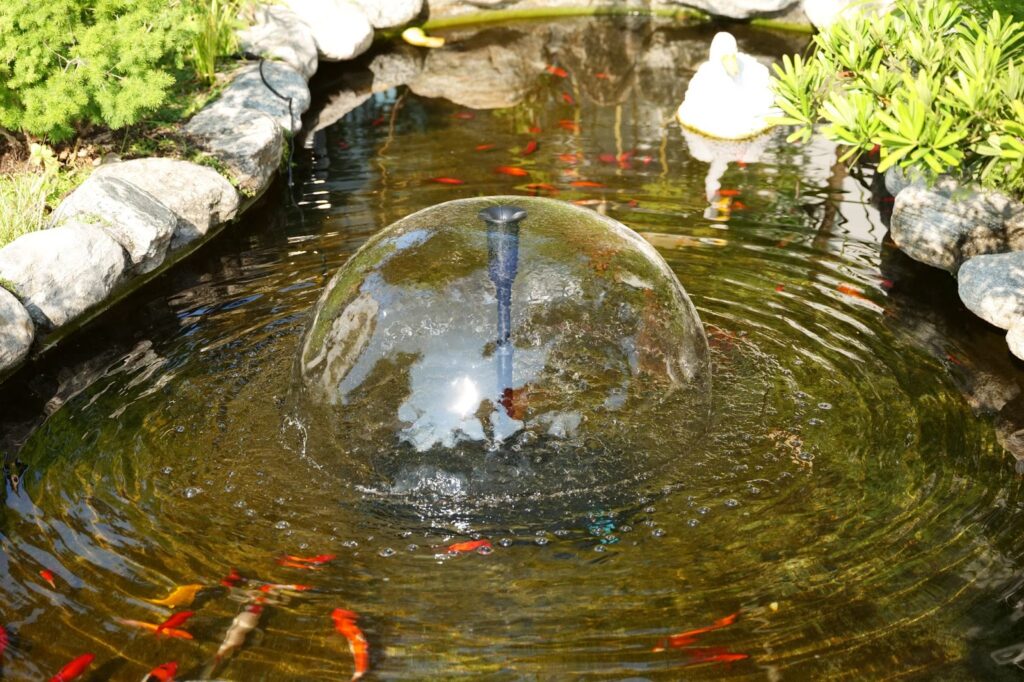
Tiny Pond, Big Impact: Small Space Pond Ideas for Urban Gardens
In the hustle and bustle of city life, having a green space to call your own is a rare treasure. Urban gardens, no matter how modest, offer a breath of fresh air and a slice of nature amid concrete jungles.
Among the most charming and transformative additions to these compact oases is a tiny pond. Despite their size, small ponds can have a huge impact enhancing aesthetics, supporting biodiversity, and promoting tranquility.
Why Add a Pond to Your Urban Garden?
A pond, even one no larger than a barrel, brings multiple benefits:
Visual Appeal: Water introduces reflective surfaces and movement, making a garden feel larger and more dynamic.
Wildlife Habitat: Frogs, birds, insects, and aquatic plants all thrive around water, creating a miniature ecosystem.
Sound and Serenity: Trickling water reduces noise pollution and adds calming background sounds.
Temperature Control: Water moderates surrounding temperatures, offering a cooler spot in the summer.
Improved Air Quality: A well-maintained pond supports plants that contribute to cleaner, more humid air.
In tight urban environments, incorporating a pond demonstrates how even the smallest patch of green can become a living, breathing sanctuary.
Planning Your Small Pond: Space, Style, and Purpose
1. Assess Your Space
Before diving in (pun intended), take stock of your available area. Consider:
Light: Sunlight is vital for aquatic plants and fish.
Access to Water and Electricity: For topping up and running small pumps or filters.
Safety: Especially important for households with children or pets.
A tiny pond doesn’t require much of a corner of a balcony, a narrow passage, or a tucked-away section of a raised bed might suffice.
2. Choose Your Pond Type
Container Ponds
Perfect for patios and balconies, these are water features built in barrels, tubs, or even recycled sinks. They’re lightweight, portable, and easy to set up.
In-ground Mini Ponds
If you have access to soil, digging a small pond, say, 2 feet across can still offer impressive results. Line it with pond liner, add stones for edges, and voilà!
Vertical Water Features
For truly space-challenged areas, consider wall-mounted water panels or cascading wall fountains that simulate the pond feel without occupying floor space.
Design Ideas for Maximum Impact
1. Repurposed Planters and Bowls
Got a ceramic planter collecting dust? Transform it into a charming pond. Waterproof it, add some aquatic plants like water lettuce or dwarf papyrus, and you're done. This approach is affordable, sustainable, and stylish.
2. Zen-Inspired Pond Corners
Borrow from Japanese garden aesthetics by incorporating smooth stones, bamboo elements, and minimalistic plantings. A shallow stone basin filled with water can exude peace and harmony, even in a tiny courtyard.
3. Tiered Pond Systems
If you’re feeling ambitious, stack containers in a tiered fashion to create a cascading water garden. Each level serves as a mini pond, with water gently flowing between them. This design uses vertical space efficiently and creates relaxing water sounds.
4. Pond with Seating Integration
Incorporate your pond into built-in seating arrangements. For example, a bench with a recessed water feature underneath adds both functionality and visual interest.
5. Hidden Oasis Design
Use tall grasses, trellises, and hanging plants to hide the pond partially. This creates a sense of discovery and adds mystery and depth to a small garden layout.
Best Plants for Small Ponds
A well-planted pond is the key to its success. Here are top choices that thrive in compact environments:
Water Lettuce: Floaters that provide shade and reduce algae.
Dwarf Water Lily: Offers beautiful blooms in small-scale ponds.
Hornwort: A submerged plant that oxygenates the water.
Pickerelweed: Attractive flowers and manageable size.
Miniature Cattails: Add vertical interest without overwhelming the space.
Remember to balance floaters, submerged plants, and marginal (edge) plants for both visual appeal and ecosystem health.
Can You Add Fish to Tiny Ponds?
Yes but with limitations. Small ponds have limited oxygen and water volume, so it’s essential to choose wisely.
Good Fish Options:
White Cloud Mountain Minnows: Hardy and small.
Mosquitofish: Eat larvae, helping with pest control.
Guppies: Colorful and low maintenance.
Avoid koi or large goldfish, as they require deeper, more spacious environments. Also, use a pond filters and monitor water quality regularly to keep your aquatic pets healthy.
Maintenance Tips for Tiny Ponds
Though small in size, these ponds require regular care to remain clean, functional, and beautiful.
Weekly:
Remove fallen leaves and debris.
Check water levels and top up with dechlorinated water.
Monthly:
Rinse filters if you’re using a pump.
Trim overgrown plants.
Test water pH and ammonia levels if fish are present.
Seasonally:
In cold climates, consider bringing container ponds indoors.
Use a small heater or aerator in winter to prevent freezing.
A tiny pond might demand frequent attention, but it pays dividends in tranquility and beauty.
Creative Small Pond Ideas for Urban Settings
1. Balcony Pond in a Wine Barrel
Wine barrels cut in half make excellent pond containers. Add a mini pump, some water hyacinths, and solar-powered lights for evening magic.
2. Recycled Bathtub Pond
Turn an old clawfoot tub into a whimsical pond. Paint it, decorate with mosaic tiles, and surround it with potted plants to soften its outline.
3. Tabletop Pond for Compact Spaces
Even a coffee table or sturdy plant stand can hold a mini water garden. Use shallow trays, line them with pebbles, and include miniature floating plants.
4. Rainwater-fed Micro Pond
Attach a rain chain or gutter diverter to direct rainwater into a small pond container. Eco-friendly and cost-effective, this setup makes the most of natural resources.
Adding Features for Drama and Function
Waterfalls and Bubblers
A gentle water flow not only oxygenates the pond but adds soothing sound. Solar pumps are great for powering small bubblers without electrical hookups.
Lighting
Use submersible LED lights or floating solar lanterns to make your pond glow at night. Strategic lighting transforms your garden into an evening retreat.
Bridge or Stepping Stones
In larger small spaces (such as rooftops), consider a tiny bridge or a few stepping stones across your pond. It enhances interactivity and aesthetics.
Eco-Friendly Tips for Urban Gardeners
Use rainwater or collected greywater to fill your pond.
Avoid harsh chemicals opt for natural algae control like barley straw.
Introduce native plants to support local pollinators.
Install a pond filters or small solar-powered pump to keep the water clear without excessive manual cleaning.
Creating a pond isn’t just about beauty, it's about sustainability and ecological enrichment, particularly in urban spaces where green life is often lacking.
Common Mistakes to Avoid
Overstocking fish: Too many fish can overwhelm the pond’s ecosystem.
Poor placement: A pond under a tree might require frequent cleaning.
Ignoring maintenance: Even the tiniest ponds need care to thrive.
Using tap water without treatment: Chlorine and other chemicals harm fish and plants.
Plan ahead, and your pond will flourish becoming a centerpiece of calm and natural beauty.
Final thoughts :
You don’t need acres of land or a sprawling backyard to enjoy the joys of a pond. A tiny pond can transform even the most modest urban garden into a lush, sensory-rich paradise. Whether nestled in a corner of a balcony or integrated into a small patio, these water features bring light, life, and serenity to tight spaces.
Let your imagination flow freely. With a touch of creativity, some strategic plantings, and a bit of care, your miniature pond can leave a lasting impression. After all, nature’s magic doesn’t depend on scale, it's the thought, design, and heart behind it that matters.
In the hustle and bustle of city life, having a green space to call your own is a rare treasure. Urban gardens, no matter how modest, offer a breath of fresh air and a slice of nature amid concrete jungles.
Among the most charming and transformative additions to these compact oases is a tiny pond. Despite their size, small ponds can have a huge impact enhancing aesthetics, supporting biodiversity, and promoting tranquility.
Why Add a Pond to Your Urban Garden?
A pond, even one no larger than a barrel, brings multiple benefits:
- Visual Appeal: Water introduces reflective surfaces and movement, making a garden feel larger and more dynamic.
- Wildlife Habitat: Frogs, birds, insects, and aquatic plants all thrive around water, creating a miniature ecosystem.
- Sound and Serenity: Trickling water reduces noise pollution and adds calming background sounds.
- Temperature Control: Water moderates surrounding temperatures, offering a cooler spot in the summer.
- Improved Air Quality: A well-maintained pond supports plants that contribute to cleaner, more humid air.
In tight urban environments, incorporating a pond demonstrates how even the smallest patch of green can become a living, breathing sanctuary.
Planning Your Small Pond: Space, Style, and Purpose
1. Assess Your Space
Before diving in (pun intended), take stock of your available area. Consider:
- Light: Sunlight is vital for aquatic plants and fish.
- Access to Water and Electricity: For topping up and running small pumps or filters.
- Safety: Especially important for households with children or pets.
A tiny pond doesn’t require much of a corner of a balcony, a narrow passage, or a tucked-away section of a raised bed might suffice.
2. Choose Your Pond Type
Container Ponds
Perfect for patios and balconies, these are water features built in barrels, tubs, or even recycled sinks. They’re lightweight, portable, and easy to set up.
In-ground Mini Ponds
If you have access to soil, digging a small pond, say, 2 feet across can still offer impressive results. Line it with pond liner, add stones for edges, and voilà!
Vertical Water Features
For truly space-challenged areas, consider wall-mounted water panels or cascading wall fountains that simulate the pond feel without occupying floor space.
Design Ideas for Maximum Impact
1. Repurposed Planters and Bowls
Got a ceramic planter collecting dust? Transform it into a charming pond. Waterproof it, add some aquatic plants like water lettuce or dwarf papyrus, and you’re done. This approach is affordable, sustainable, and stylish.
2. Zen-Inspired Pond Corners
Borrow from Japanese garden aesthetics by incorporating smooth stones, bamboo elements, and minimalistic plantings. A shallow stone basin filled with water can exude peace and harmony, even in a tiny courtyard.
3. Tiered Pond Systems
If you’re feeling ambitious, stack containers in a tiered fashion to create a cascading water garden. Each level serves as a mini pond, with water gently flowing between them. This design uses vertical space efficiently and creates relaxing water sounds.
4. Pond with Seating Integration
Incorporate your pond into built-in seating arrangements. For example, a bench with a recessed water feature underneath adds both functionality and visual interest.
5. Hidden Oasis Design
Use tall grasses, trellises, and hanging plants to hide the pond partially. This creates a sense of discovery and adds mystery and depth to a small garden layout.
Best Plants for Small Ponds
A well-planted pond is the key to its success. Here are top choices that thrive in compact environments:
- Water Lettuce: Floaters that provide shade and reduce algae.
- Dwarf Water Lily: Offers beautiful blooms in small-scale ponds.
- Hornwort: A submerged plant that oxygenates the water.
- Pickerelweed: Attractive flowers and manageable size.
- Miniature Cattails: Add vertical interest without overwhelming the space.
Remember to balance floaters, submerged plants, and marginal (edge) plants for both visual appeal and ecosystem health.
Can You Add Fish to Tiny Ponds?
Yes but with limitations. Small ponds have limited oxygen and water volume, so it’s essential to choose wisely.
Good Fish Options:
- White Cloud Mountain Minnows: Hardy and small.
- Mosquitofish: Eat larvae, helping with pest control.
- Guppies: Colorful and low maintenance.
Avoid koi or large goldfish, as they require deeper, more spacious environments. Also, use a pond filters and monitor water quality regularly to keep your aquatic pets healthy.
Maintenance Tips for Tiny Ponds
Though small in size, these ponds require regular care to remain clean, functional, and beautiful.
Weekly:
- Remove fallen leaves and debris.
- Check water levels and top up with dechlorinated water.
Monthly:
- Rinse filters if you’re using a pump.
- Trim overgrown plants.
- Test water pH and ammonia levels if fish are present.
Seasonally:
- In cold climates, consider bringing container ponds indoors.
- Use a small heater or aerator in winter to prevent freezing.
A tiny pond might demand frequent attention, but it pays dividends in tranquility and beauty.
Creative Small Pond Ideas for Urban Settings
1. Balcony Pond in a Wine Barrel
Wine barrels cut in half make excellent pond containers. Add a mini pump, some water hyacinths, and solar-powered lights for evening magic.
2. Recycled Bathtub Pond
Turn an old clawfoot tub into a whimsical pond. Paint it, decorate with mosaic tiles, and surround it with potted plants to soften its outline.
3. Tabletop Pond for Compact Spaces
Even a coffee table or sturdy plant stand can hold a mini water garden. Use shallow trays, line them with pebbles, and include miniature floating plants.
4. Rainwater-fed Micro Pond
Attach a rain chain or gutter diverter to direct rainwater into a small pond container. Eco-friendly and cost-effective, this setup makes the most of natural resources.
Adding Features for Drama and Function
Waterfalls and Bubblers
A gentle water flow not only oxygenates the pond but adds soothing sound. Solar pumps are great for powering small bubblers without electrical hookups.
Lighting
Use submersible LED lights or floating solar lanterns to make your pond glow at night. Strategic lighting transforms your garden into an evening retreat.
Bridge or Stepping Stones
In larger small spaces (such as rooftops), consider a tiny bridge or a few stepping stones across your pond. It enhances interactivity and aesthetics.
Eco-Friendly Tips for Urban Gardeners
- Use rainwater or collected greywater to fill your pond.
- Avoid harsh chemicals opt for natural algae control like barley straw.
- Introduce native plants to support local pollinators.
- Install a pond filters or small solar-powered pump to keep the water clear without excessive manual cleaning.
Creating a pond isn’t just about beauty, it’s about sustainability and ecological enrichment, particularly in urban spaces where green life is often lacking.
Common Mistakes to Avoid
- Overstocking fish: Too many fish can overwhelm the pond’s ecosystem.
- Poor placement: A pond under a tree might require frequent cleaning.
- Ignoring maintenance: Even the tiniest ponds need care to thrive.
- Using tap water without treatment: Chlorine and other chemicals harm fish and plants.
Plan ahead, and your pond will flourish becoming a centerpiece of calm and natural beauty.
Final thoughts :
You don’t need acres of land or a sprawling backyard to enjoy the joys of a pond. A tiny pond can transform even the most modest urban garden into a lush, sensory-rich paradise. Whether nestled in a corner of a balcony or integrated into a small patio, these water features bring light, life, and serenity to tight spaces.
Let your imagination flow freely. With a touch of creativity, some strategic plantings, and a bit of care, your miniature pond can leave a lasting impression. After all, nature’s magic doesn’t depend on scale, it’s the thought, design, and heart behind it that matters.



